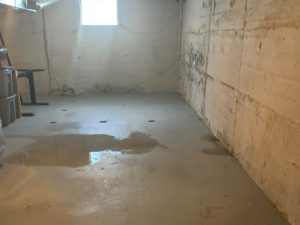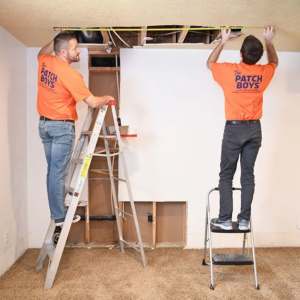If you’ve noticed water stains on your basement walls or odors of mold, you should take immediate action. This will protect your valuables, keep you and your family healthy, and reduce future damage to your home.
Small cracks may be fixed with DIY interior crack repair, but bowing walls require a thorough foundation inspection. An expert inspection will reveal the cause of basement wall cracking and provide insight into the best repair methods. Contact Basement Repair Naperville IL now!

If water enters a basement through cracks in the walls or around windows, it can cause significant damage and threaten the structural integrity of your home. It may also promote mold and mildew growth, leading to musty odors and health problems. This moisture can also deteriorate carpet, wood and other personal belongings. If the problem goes untreated, it can even compromise a basement or crawl space’s value and comfort.
Waterproofing is a critical part of basement repair that prevents moisture from seeping into the walls, floor and foundation. Most contractors offer both interior and exterior waterproofing treatments. However, exterior treatment requires excavation and is generally a more expensive option. Interior basement waterproofing involves lining the basement walls with a waterproof membrane to prevent moisture from entering the basement. It’s important to hire a reputable contractor to ensure the best results. Check the company’s credentials, including Better Business Bureau ratings and accreditations, online reviews and customer referrals. In addition, ask the contractor to explain how the method they use works and for examples of past projects.
While some interior waterproofing methods are effective at managing moisture after it’s already inside your home, these measures are only temporary and don’t address the root causes of the problem. The best way to avoid the need for future basement waterproofing is to address the source of the problem in the first place. For example, install a french drain or sump pump to redirect water from the soil and away from your foundation, so it doesn’t build up hydrostatic pressure and disrupt your home’s foundation.
Addressing both settling foundations and basement waterproofing at the same time can reduce the need for future repairs, save money and improve your home’s strength, safety and overall value. Combining these services can also prevent moisture damage, which can affect the integrity of your home’s foundation and lead to costly repairs in the future.
Repairing Cracks
The walls of your basement serve a vital role: They support the weight of your house, resist moisture that seeps from the soil and protect your belongings from water damage. However, they can develop cracks due to ground movement or structural settlement. Unless you address these cracks, they can compromise the stability of your foundation and cause extensive damage to your home.
Depending on the type of basement crack, there are several different repair methods available. Structural basement wall cracks may require substantial intervention to stabilize and seal them, while non-structural cracks can be repaired using minimally invasive solutions.
Most basement cracks are hairline and vertical, caused by settling or shrinkage of the concrete. They may form at the point where the basement floor meets the foundation wall, or elsewhere in the basement walls. Cracks of this sort usually pose no serious problem and can be sealed with a caulk that is compatible with concrete.
Other, larger cracks are often a sign of serious structural problems and should be addressed immediately. These cracks are likely to widen further and can be a source of moisture intrusion into your basement. Leaks and deteriorating basement walls lead to mold growth, which can cause health issues for you and your family. Additionally, they can reduce your property value and turn off potential buyers.
Basement cracks can also indicate a bowed basement wall. This happens when the foundation is being pushed in from the top or bottom, and it can cause shearing at the corners of your basement. Bowed basement walls can be repaired by installing carbon fiber straps or wall plate anchors, which are driven into the soil outside your basement walls to stabilize and straighten them.
Regardless of the reason for your basement cracks, it’s important to get them repaired as soon as possible to limit the impact on your home and prevent further damage. Professional basement repair methods are more costly upfront, but they can offer long-term cost savings by reducing future damage and preventing the need for more extensive repairs down the line.
Bowed Walls
Bowing walls in a basement are not only unsightly, they can also indicate significant structural damage. Bowed walls are usually the result of pressure on the foundation, and left unaddressed they can lead to more severe issues in your home, including cracks, leaks, and even wall collapse.
If you notice that your basement walls are bowing inward, you should contact a professional immediately to inspect and repair the issue. The exact cost of a bowing wall repair will depend on the severity and extent of the damage, but there are several widely-used methods to address the problem.
Carbon fiber straps are a popular, low-cost option that reinforces the wall and redistributes pressure evenly on both sides of the wall. They can also be painted to blend in and are nearly invisible when installed inside your home.
Steel I-beams are another option for repairing bowed basement walls, particularly in cases where the bowing is severe and external access is not possible. These vertical steel reinforcement beams redistribute the weight and pressure on the foundation, helping to straighten the wall over time.
Helical tiebacks are another effective, but more expensive, solution for bowed basement walls. These long, screw-like shafts are drilled into the soil outside your foundation and twisted through a hole in your basement wall until a certain torque is reached. This process gradually straightens the wall and stabilizes it against further movement.
Wall anchor systems are a more invasive solution for repairing bowed walls, and require excavating around your foundation to place the anchors in stable soil. Once the anchors are in place, they are connected to steel rods that can be tightened over time to gradually pull your basement wall back into its original position.
The most important thing to remember when evaluating the costs of a bowed basement wall repair is that ignoring the issue will only make it worse. Not only can this damage the value of your home, but it can also pose a safety risk for you and your family. Contact a trusted foundation repair specialist to have your bowed basement wall assessed and repaired as soon as possible.
Leaking Basements
Basements are designed to be usable living space, but they can quickly become unusable if there’s a leak. This is because moisture can damage belongings, encourage mold and mildew growth, deteriorate the concrete foundation, erode soil and contribute to structural instability in the house. It’s important to have a permanent solution to the problem so that it doesn’t get worse over time.
During heavy rains, if the water in your basement is near the walls, then it’s probably due to rising groundwater and saturated soil that creates hydrostatic pressure that pushes against the foundation walls opportunistically. This is why basement waterproofing and proper grading are so important.
If the water in your basement is higher up, close to where the wall meets the floor, then it’s likely due to a structural crack in a poured concrete basement. In these situations, a permanent solution is injection of the crack from inside the basement with expanding polyurethane. This fills and seals the crack out to the soil while remaining flexible to prevent minor foundation movement from re-opening the crack.
A leaking basement is not only unsightly but also dangerous for your family’s health and can be detrimental to your home’s value. It can cause damage to belongings, promote the growth of mold and mildew which can aggravate allergies and other respiratory problems, damage furniture, ruin electronics and lead to structural damage in your home’s foundation.
A leaking basement can also be an indicator that your foundation is weakening, which requires immediate attention to reduce the risk of further damage and costly repairs. Don’t wait to call Anchored Walls for a professional inspection and permanent basement repair. Our experienced crew can restore your basement to its full potential and protect your home’s value. Contact us today to schedule an appointment. We proudly serve Charlotte, NC and the surrounding areas. We are licensed, insured, and bonded. Our customers are always treated with the highest standard of care. We provide free, no-pressure estimates on all of our services and offer competitive pricing. We are proud to be a member of the Better Business Bureau.








